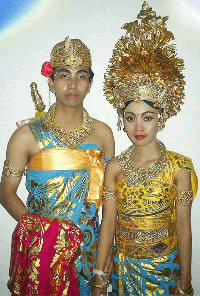 Penjor is made from a long bamboo pole about eight meter high with curved end, and decorated with palm leaves, rice paddies, corn on the cob, coconut, cakes, a piece of white or yellow cloth, etc. It is the symbol of Mount Agung and also as gratitude for the agricultural produce. The arched top of the bamboo pole represents Mount Agung, the body of the pole is a river that flows from the mountains to the sea, and along its route are the products of the harvest, tied to the pole.
Penjor is made from a long bamboo pole about eight meter high with curved end, and decorated with palm leaves, rice paddies, corn on the cob, coconut, cakes, a piece of white or yellow cloth, etc. It is the symbol of Mount Agung and also as gratitude for the agricultural produce. The arched top of the bamboo pole represents Mount Agung, the body of the pole is a river that flows from the mountains to the sea, and along its route are the products of the harvest, tied to the pole.Each part and ornament of Penjor is not merely an ornament but it has a deep religious meaning. For instance bamboo pole is a symbol of strong determination to serve God. The four essential ornaments of Penjor which are Tamyang, Bakang-bakang, Sampyan, and Lamak are symbol of Catur Weda (four divisions of Hindu Holy Scripture which are Atarwa Weda, Sama Weda, Yayur Weda and Rg Weda).
Balinese believed that the best way to express gratitude to the God is making an offering which is comprise of all God's grace (crops, clothes, etc). This also serves as a sign for reminding the human that everything we enjoy in this world is from the God. Sanggah cucuk, A triangle shaped temporary shrine is attached at the foot of the penjor. This shrine serves as a place for placing additional offering which is offered on Galungan day.
Ubag-abig a square ornament made of palm and cocunut leaves represents the power of virtue. Palm leaves, rice paddies, corn on the cob, coconut, cakes, and a piece of white or yellow cloth are the symbol of prosperity and gratitude to Ida Sanghyang Widhi (God Almighty).
Penjor is stuck along side of the road, precisely on the left side of house compound entrance. The penjor is not just stuck on the ground, installation of penjor requires an offering comprise of Kwangen (simple arrangement of flowers on banana leaf) and 11 pieces of Pis Bolong (traditional Balinese coin) place in the hole where penjor is going to be stuck. Penjor is installed on Penampahan Galungan (a day before Galungan).
After 42 days penjor is removed with special offering. All penjor's ornaments are burnt and the ashes penjor's ornaments are put into a yellow coconut and buried in house compound. Other alternative is the ashes of penjor's ornaments are put into the hole where penjor had been stuck with an offering of special porridge made of rice flour, milk, honey and 3 padang lepas leaves.
[More...]

